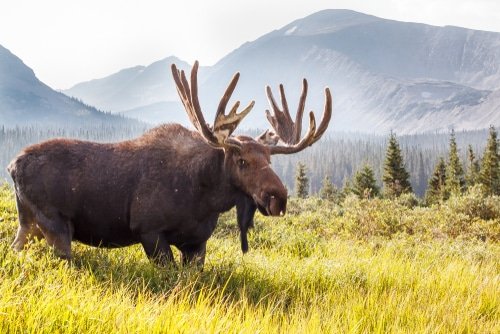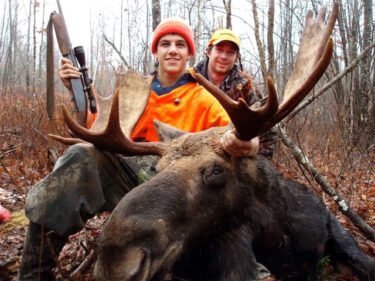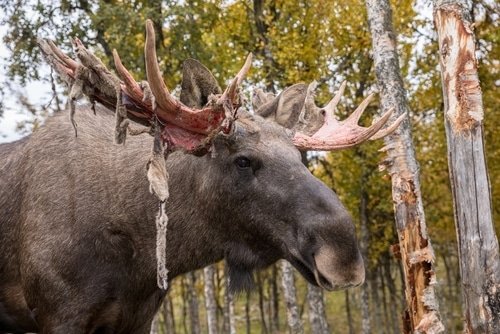Majestic, awe-inspiring, and captivating – these are just a few words that come to mind when we think of the mighty moose. But have you ever wondered about the secrets hidden within their behavior and population dynamics? Well, you’re in for a treat! In this article, we dive deep into the world of moose research and studies to unravel the enigmatic lives of these magnificent creatures.
Studying Moose Population and Behavior
Moose play a crucial role in maintaining ecological balance in their habitats. Understanding their population dynamics is vital for effective wildlife management and conservation strategies. Scientific studies on moose provide invaluable insights into population size, reproduction rates, mortality rates, and migration patterns.
By closely examining these aspects, researchers can assess the health of moose populations and identify potential threats they face. Furthermore, exploring moose behavior allows us to comprehend their social structure, communication methods, mating rituals, feeding habits, and more.
Such knowledge sheds light on how they interact with their environment and other species. It enables scientists to devise comprehensive conservation plans that consider not only the protection of individual animals but also entire ecosystems.
Role of Research in Conservation Efforts
Research forms an essential foundation for conservation efforts to safeguard moose populations for future generations. Without a thorough understanding of their needs and vulnerabilities, preservation initiatives would lack direction and effectiveness.
The findings from scientific studies on moose guide policymakers in making informed decisions regarding habitat preservation measures like land designation or protected areas establishment. They also assist wildlife agencies in establishing hunting regulations that maintain sustainable harvest levels while ensuring long-term population stability.
In addition to this direct impact on policy-making processes, research paves the way for innovative conservation strategies. By identifying and mitigating threats such as habitat loss, climate change, and disease outbreaks, scientists can implement proactive measures to mitigate negative impacts on moose populations.
In the next section, we delve into the fascinating world of moose anatomy and physiology. Get ready to be amazed by the remarkable adaptations that enable these magnificent creatures to thrive in diverse environments!
Moose Anatomy and Physiology
Overview of moose physical characteristics
When it comes to physical appearance, moose are truly fascinating creatures. These majestic mammals can reach impressive sizes, with adult males, or bulls, towering up to 6 feet at the shoulder and weighing over 1,000 pounds. Their bodies are covered in a dense coat of coarse hair that varies from dark brown to almost black.
Their most distinctive feature is undoubtedly their antlers – massive branched structures that adorn the heads of mature males during the breeding season. These antlers can span up to 6 feet across and serve as a symbol of dominance and attractiveness during mating rituals.
Adaptations for survival in different environments
Moose have developed several remarkable adaptations that allow them to thrive in various environments across their wide distribution range. One such adaptation is their long legs, which enable them to navigate through deep snow and wet marshlands with ease.
These lengthy limbs also grant them an exceptional ability to swim long distances, making water bodies like lakes and rivers no obstacle for these resilient creatures. Additionally, moose have specialized snouts equipped with a unique nose structure that aids in efficiently browsing vegetation, especially underwater plants found in their preferred habitats near lakes and ponds.
Moreover, they possess a keen sense of hearing and smell that helps them detect predators or potential mates from afar. All these adaptations have been subject to extensive scientific studies on moose research advancements.
Moose Habitat and Distribution
Global Distribution of Moose Species
The moose, magnificent as it is, has quite an extensive global presence. These majestic creatures have managed to establish themselves in various regions around the world.
From North America to Europe and even parts of Asia, the moose has left its hoofprints on many continents. In North America, they can be found in Alaska, Canada, and parts of the northern United States.
In Europe, countries like Sweden, Norway, and Finland boast healthy moose populations. Additionally, in Asia, Siberia is home to many gentle giants.
Preferred Habitats and Factors Influencing Their Choice
Moose are known for their adaptability when it comes to choosing habitats. However, they do have certain preferences that influence their decision-making process. Dense forests serve as ideal landscapes for moose due to the abundance of nutritious browse vegetation like willow shrubs and birch trees they rely heavily on for sustenance.
Wetlands are another favorite hangout spot for these creatures since they provide them with ample water sources for hydration as well as aquatic plants for munching. Factors such as climate also play a role in habitat selection.
Moose often prefer cooler regions where summers are mild and winters are snowy. It helps them regulate body temperature more efficiently while reducing exposure to pesky insects like mosquitoes, with an unfortunate affinity for moose blood. While each population may exhibit unique adaptations according to their specific environment, understanding these preferred habitats allows researchers to target their efforts more effectively when conducting scientific studies on moose behavior or population dynamics.
So next time you find yourself wandering through a dense forest or exploring a picturesque wetland area with lush vegetation around you – keep your eyes peeled! You might stumble upon some fascinating clues about the distribution patterns of our beloved moose friends.
Moose Behavior and Social Structure
Mating rituals and courtship displays
When it comes to finding a mate, moose have their unique way of doing things. The males, known as bulls, engage in impressive displays of strength and dominance to attract females or cows.
During the mating season, also called the rut, the bulls engage in fierce battles with one another using their antlers as weapons. This spectacle is not just about physical prowess; it’s also a way for bulls to establish dominance and win over potential mates.
The victorious bull will then perform elaborate courtship displays by thrashing his antlers and emitting deep guttural calls to woo the females. These rituals are not only fascinating to witness but have been extensively studied through scientific research on moose behavior.
Hierarchical structure within moose herds
Moose are social animals that live in herds, usually consisting of a dominant bull, several cows, and their offspring. Within these herds, a hierarchical structure exists where the dominant bull controls the group. The hierarchy is established through fights between bulls during the rutting season when they compete for mating rights with the females.
Once dominance is established, the dominant bull exerts authority by leading the herd and defending it against potential threats such as predators or rival males. This hierarchical structure is not only essential for maintaining order within moose communities but also influences access to resources such as food and shelter.
Lower-ranking males may be excluded from prime grazing areas or pushed to the outskirts of the herd,d where they have less chance of mating with receptive females. Scientific studies on moose behavior have shed light on these intricate dynamics within moose herds.
Through careful observation and data collection techniques like radio tracking collars or behavioral experiments, researchers have unraveled many aspects of how moose navigate their social interactions and maintain their hierarchical structure. These moose research advancements not only deepen our understanding of these majestic creatures but also contribute to conservation efforts by informing management practices that protect and preserve their natural habitats.
Feeding Habits and Diet Preferences
Tastes of the Wild: Types of Vegetation Consumed by Moose
When it comes to food, moose can be quite picky eaters. These majestic creatures have a diverse palate and enjoy munching on various vegetation. Their diet primarily consists of browse, which includes the tender shoots, leaves, and twigs of various trees and shrubs.
Moose are particularly fond of willow, aspen, birch, and maple trees. They also have a voracious appetite for aquatic plants such as water lilies and pondweed.
But their culinary escapades don’t end there! These herbivores also munch on grasses, sedges, and even certain fungi when stumble upon them during their forest foraging adventures.
Nature’s Seasonal Menu: Seasonal Variations in Diet Choices
Just like humans crave pumpkin spice lattes in autumn (don’t judge!), moose also have seasonal gustatory preferences. Their diet choices change with the shifting seasons.
During spring and summer, when foliage is abundant, moose indulge in fresh green shoots and leaves that emerge with warmer weather. As autumn rolls around and deciduous trees drop their leaves like confetti at a woodland party, moose focus on consuming large quantities of fallen leaves that blanket the forest floor.
But perhaps the most exciting culinary spectacle happens during winter when snow covers the ground like a fluffy white blanket. In this frosty wonderland devoid of leafy snacks, moose turn into avid bark munchers!
Yes, you heard it right – bark! They strip away strips of bark from tree trunks using their strong teeth to access the nutrient-rich cambium layer beneath.
This unconventional winter feast helps sustain these magnificent creatures when other food sources are scarce. Scientific studies on moose have revealed that these seasonal variations in their diet play a crucial role in their overall health and survival.
It’s fascinating how they adapt their munching habits to the ever-changing buffet nature provides. So, next time you stroll through the woods, take a moment to appreciate the delicate balance of flavors on a moose’s menu, evolving gracefully with each passing season.
Reproduction and Life Cycle
Moose Reproductive Strategies
When wooing their potential mates, moose don’t mess around. The males, known as bulls, engage in fierce competition for the attention of the female, or cows. This competition involves some serious posturing and vocalizations that could put any reality TV show to shame.
The dominant bull asserts his dominance by displaying his massive antlers and emitting deep grunts that resonate through the forest. These displays are meant to intimidate rival males and attract the attention of nearby females.
In their quest for mating success, male moose are notorious for engaging in battles called “rutting,” where they clash their antlers with incredible force. It’s like a heavyweight boxing match in the animal kingdom!
Growth Stages from Birth to Adulthood
Once a female moose becomes pregnant after successful mating, she carries her calf for about eight months before giving birth in late spring or early summer. Moose calves are born with long legs and reddish-brown fur that help them blend into their surroundings seamlessly and avoid predators like wolves or bears. These adorable little ones stay close to their mothers during their early days as they learn to navigate the world around them.
By feeding on nutritious milk provided by their mothers, moose calves rapidly grow in size and strength through a process called “nursing.” As they do, these youngsters start sampling vegetation alongside milk until they transition completely onto a diet of grasses, leaves, bark, twigs, and even aquatic plants. Understanding moose reproduction strategies is crucial to appreciating the fascinating dynamics of these magnificent creatures’ lives.
From intense battles between rival bulls to adorable calves taking their first uncertain steps into the world, each stage of a moose’s life cycle offers unique insights into its survival and adaptation strategies. Scientific studies on moose have shed light on their intricate behaviors, ensuring that future generations can continue to marvel at the wonders of these majestic animals.

Moose Communication
Vocalizations Used for Different Purposes
Moose have a diverse range of vocalizations that they use to communicate with other individuals in their herd and to express various emotions. One of the most commonly heard vocalizations is the deep and resonant call known as the “moose call” or “bull grunt.” This powerful sound, produced by male moose during the mating season, serves as a way to attract female mates and establish dominance over other males.
It can sometimes be heard from miles away, echoing through the forest. Also, moose make softer grunts, snorts, and mews as communication signals during non-mating periods. These sounds help them maintain contact with their herd members and convey their intentions or warnings.
Body Language Cues Among Individuals
Aside from vocalizations, moose also rely on body language cues to communicate with one another effectively. They have various physical gestures that convey different messages depending on the context.
For instance, when a moose feels threatened or wants to assert its dominance, it may lower its head, elevate its mane, and hold its ears backward against its neck. This aggressive posture sends a clear signal to rivals or potential predators that they should keep their distance.
On the other hand, when feeling relaxed or contented, moose may hold their ears in a more relaxed position and exhibit calm movements like grazing leisurely or nudging each other gently. Overall, moose communication is fascinating to observe and study.
Researchers have made significant progress in understanding various vocalizations and body language cues through careful observation in the wild. These insights contribute to our knowledge about social dynamics within herds and help us better comprehend how these majestic creatures interact with one another in their natural habitats.
Moose Predators and Threats
Natural predators that pose a threat to moose survival
When it comes to the natural predators that challenge the mighty moose, few can rival the power and cunning of the gray wolf. Wolves, being skilled hunters, often target weaker or vulnerable members of the moose population. They employ coordinated strategies to bring down these majestic creatures, using their sharp teeth and powerful jaws to inflict fatal injuries.
Additionally, packs of coyotes have been known to harass young or injured moose, making their lives even more precarious. Scientific studies on moose predation have shed light on these fascinating predator-prey dynamics and how they shape both populations.
Human-induced threats like hunting, habitat loss, climate change
While natural predators play a significant role in shaping moose populations, human activities have become an alarming threat to their survival. Hunting has long been a recreational pursuit for many individuals, but when carried out irresponsibly or unsustainably, it can disrupt delicate ecological balance. Regulated hunting practices are essential to prevent overharvesting and maintain healthy population numbers.
On another front, habitat loss due to deforestation and urbanization deprives moose of their preferred environments. Increasingly concerning is the impact of climate change on these gentle giants.
Rising temperatures alter vegetation patterns, affecting food availability and changing snowpack dynamics, which can impede movement during critical seasons like winter. Understanding both natural predator-prey relationships and human-induced threats is crucial for effective conservation efforts aimed at preserving this iconic species: the magnificent moose!
Moose Research Techniques
Tracking methods used to study movement patterns
When understanding how moose move about in their vast habitats, scientists have employed various tracking methods to gather valuable data. One common technique involves fitting moose with radio collars that emit signals, allowing researchers to track their movements using specialized receivers. This allows scientists to map out the routes these magnificent creatures take as they forage, migrate, or establish territories.
Additionally, satellite tracking has revolutionized the field of moose research. By attaching GPS collars to these majestic animals, scientists can receive real-time updates on their locations and even track them remotely from the comfort of their research facilities.
Technological advancements aiding in data collection
Thanks to ongoing technological advancements, gathering data on moose populations has become significantly more efficient and accurate. Infrared-triggered trail cameras have proven particularly valuable in capturing images of moose in their natural habitats without human interference.
These cameras are strategically placed along game trails or near feeding areas and provide crucial insights into behavior patterns, such as feeding habits or individual interactions. In addition, drones with high-resolution cameras have enabled researchers to survey large areas and obtain aerial imagery of moose populations with minimal disturbance.
These technological marvels have not only expanded our knowledge but have also reduced the stress on these magnificent creatures during scientific studies on moose. By utilizing these innovative tracking methods and benefiting from technological advancements aiding in data collection, scientists can paint a more comprehensive picture of moose behavior and movement patterns than ever.
These invaluable tools not only enhance our understanding but also contribute greatly towards conservation efforts by providing key insights into habitat preferences and potential threats faced by these iconic animals. The future holds even more promise for further technological advancements that will undoubtedly propel our knowledge of moose research forward in leaps and bounds.
Current Challenges in Moose Conservation
Impact of Climate Change on Habitat Availability
As our planet continues to face the consequences of climate change, moose populations are encountering a significant challenge in habitat degradation and alteration. Rising temperatures and erratic weather patterns affect the availability of suitable habitats for these majestic creatures.
The warming climate has led to changes in vegetation distribution and altered the timing of key ecological events, such as snowmelt and plant growth cycles. Moose heavily rely on specific vegetation types for sustenance, shelter, and reproduction.
With shifting climatic conditions, their preferred habitats may no longer provide adequate resources or become inaccessible due to changes in plant composition or range shifts. Understanding the dynamic relationship between climate change and moose habitat is crucial for conservation efforts.
Disease Outbreaks Affecting Moose Populations
In recent years, moose populations have faced severe challenges from various diseases that have impacted their overall health and survival rates. One example is Chronic Wasting Disease (CWD), a contagious neurological disorder affecting deer, elk, and moose. CWD has spread across several states in North America, leading to concerns about its potential impact on moose populations.
Another disease that poses a threat is Winter Tick Infestation. These tiny parasites attach themselves to moose during winter when they grow a thick coat for insulation against cold temperatures.
However, an overabundance of ticks can weaken moose by causing excessive itching, blood loss, anemia, hair loss, and even death in extreme cases. With changing environmental conditions influencing disease vectors’ behavior patterns and distribution ranges, monitoring disease outbreaks among moose populations becomes vital for effective conservation strategies.
Considering these challenges posed by climate change impacts on habitat availability alongside disease outbreaks affecting vulnerable moose populations highlights the urgent need for further research advancements and scientific studies on moose behavior patterns as well as the development of innovative conservation strategies. By gaining a comprehensive understanding of the complex interplay between ecological factors, human activities, and moose populations, we can work towards finding sustainable solutions to ensure the long-term survival and flourishing of these remarkable creatures in the face of changing environmental conditions.
Successful Conservation Initiatives
Examples of Successful Reintroduction Programs
One shining example of a successful moose reintroduction program can be found in the state of Maine, where efforts were made to restore the dwindling moose population. In the late 1970s, only about 50 moose could be found in the entire state.
However, through careful planning and implementation of conservation strategies, including controlled hunting and habitat restoration, the moose population has rebounded significantly over the past few decades. Today, Maine boasts a robust population of over 60,000 moose.
Another noteworthy success story comes from Sweden’s Värmland region. In the early 20th century, moose were nearly wiped out due to excessive hunting and habitat loss.
However, with dedicated conservation efforts and strict hunting regulations, Värmland now enjoys a thriving population of around 10,000 moose. These success stories demonstrate that with targeted interventions and a commitment to conservation goals, it is indeed possible to reverse declining populations and restore balance to ecosystems.
Community Involvement in Protecting Moose Habitats
Conservation efforts are not solely reliant on scientific studies on moose or research advancements; they also depend on active involvement from local communities. Recognizing this crucial aspect, various initiatives have engaged communities in protecting moose habitats. In Minnesota’s Superior National Forest, for instance, community members have come together to form volunteer groups focused on monitoring and managing crucial moose habitats.
These passionate individuals work tirelessly to gather data on population trends and contribute to habitat improvement projects such as reforestation efforts. In Canada’s Algonquin Provincial Park, education and awareness programs have been established to engage visitors in responsible wildlife viewing practices while highlighting the importance of preserving pristine moose habitats.
By involving communities in these endeavors through education campaigns and actively seeking their input for conservation plans, a sense of ownership and stewardship is fostered, leading to more sustainable outcomes. By sharing success stories and fostering community engagement, we can inspire others to take part in protecting these magnificent creatures and ensuring the long-term conservation of their habitats.
Future Directions in Moose Research
Potential areas for further study (e.g., genetics, behavior)
As we delve deeper into the fascinating world of moose research, there are exciting avenues for future exploration that hold immense potential. One such area is the realm of genetics.
Understanding the genetic makeup of different moose populations can provide valuable insights into their evolutionary history, adaptability to changing environments, and even disease susceptibility. By studying their genetic diversity, scientists can gain a clearer picture of how different populations are interconnected and identify key genes responsible for essential traits.
Another promising field is behavioral research. Observing and analyzing intricate aspects of moose behavior can help unravel the complexities of their social structures, communication patterns, and mating rituals.
By using advanced tracking technologies and remote sensing tools, researchers can collect detailed data on moose movements and interactions. This could show how these majestic creatures navigate their habitat, choose feeding grounds or mates, and adapt to human disturbances.
Conclusion
Moose research advancements and scientific studies on these majestic creatures have helped us better appreciate their ecological importance. Through meticulous studies of their anatomy, habitat preferences, social behavior, feeding habits, reproduction strategies, and communication methods—we have gained invaluable knowledge about these magnificent animals.
The future of moose research holds great promise in unlocking further mysteries surrounding genetics and behavior. As we strive towards a more comprehensive understanding of this iconic species—armed with this knowledge—we are better equipped to implement effective conservation efforts ensuring the long-term survival of our magnificent moose population.







Good day! Do you know if they make any plugins to assist with Search Engine Optimization? I’m trying to get
my website to rank for some targeted keywords but I’m not seeing very good
success. If you know of any please share. Appreciate it!
I saw similar blog here: Bij nl
I don’t think the title of your article matches the content lol. Just kidding, mainly because I had some doubts after reading the article.
We’ll take a close take a look at a few of the general methods IT experts use to integrate multiple sources of data and enter the world of database management.